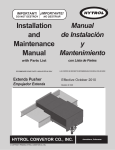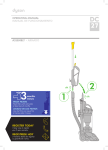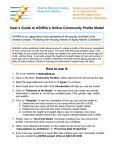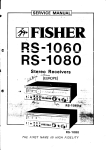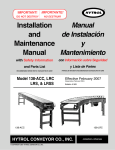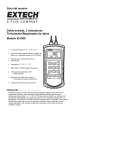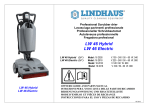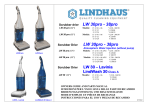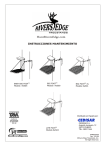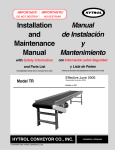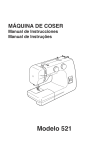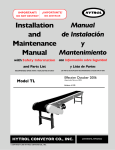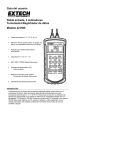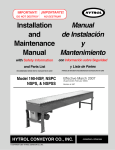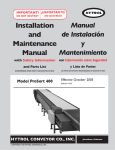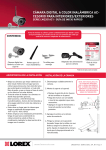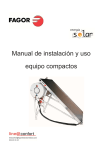Download Swing Arm Diverter - Hytrol Conveyor Company, Inc.
Transcript
IMPORTANT! DO NOT DESTROY Swing Arm Diverter Swing Arm Plow Installation and Maintenance Manual with Safety Information Bulletin #627 Effective January 2011 HYTROL CONVEYOR CO., INC. © COPYRIGHT PENDING–HYTROL CONVEYOR CO., INC. Jonesboro, Arkansas l Table of Contents l Índice INTRODUCTION Receiving and Uncrating.........................................3 INTRODUCCIÓN Recepción y Desembalaje......................................4 INSTALLATION Safety Precautions..................................................3 Initial Inspection......................................................5 Installation...............................................................5 Electrical Equipment...............................................7 INSTALACIÓN Medidas de Seguridad............................................4 Inspección Inicial.....................................................6 Instalación...............................................................6 Equipo Eléctrico......................................................8 SYSTEM START-UP Operation Safety Precautions.................................9 Swing Arm Start-Up................................................9 Maintenance Safety Precautions............................9 ARRANQUE DEL SISTEMA Medidas de Seguridad Durante la Operación.........10 Arranque del Brazo Oscilante.................................10 Medidas de Seguridad Durante el Mantenimiento..10 OPERATION Electrical................................................................11 Maintenance..........................................................11 Plow General Information......................................12 Wiring Diagram 120VAC Swing Arm Diverter........13 Wiring Diagram 24VDC Swing Arm Diverter.........14 Wiring Diagram 120VAC Swing Arm Plow............15 Wiring Diagram 24VDC Swing Arm Plow..............15 MODEL SWING ARM DIVERTER Cylinder Kit...........................................................16 Plow Arm Kit.........................................................17 Plow Assembly......................................................18 OPERACIÓN Eléctrica.................................................................11 Mantenimiento.......................................................11 Información General del Brazo..............................12 Diagrama de Cableado 120VCA-Brazo Oscilante Desviador...............................................................13 Diagrama de Cableado 24VCD-Brazo Oscilante Desviador...............................................................14 Diagrama de Cableado 120VCA-Brazo Oscilante.15 Diagrama de Cableado 24VCD-Brazo Oscilante...15 MODEL SWING ARM PLOW Cylinder Kit - 30 and 45 Degree...........................19 Plow Arm Kit - 30 Degree.....................................20 Plow Arm Kit - 45 Degree.....................................21 Plow Assembly - 30 Degree.................................22 Plow Assembly - 45 Degree.................................23 MAINTENANCE Trouble Shooting...................................................24 Preventive Maintenance........................................24 How to Order Replacement Parts.........................24 Recommended Spare Parts List...........................24 2 MODELO BRAZO OSCILANTE DESVIADOR Kit del Cilindro........................................................16 Kit del Brazo...........................................................17 Ensamble del Brazo...............................................18 MODELO BRAZO OSCILANTE Kit del Cilindro - 30 y 45 Grados............................19 Kit del Brazo - 30 Grados.......................................20 Kit del Brazo - 45 Grados.......................................21 Ensamble del Brazo - 30 Grados...........................22 Ensamble del Brazo - 45 Grados...........................23 MANTENIMIENTO Resolviendo Problemas..........................................25 Mantenimiento Preventivo......................................25 Como Ordenar Partes de Repuesto.......................25 Lista de Partes de Repuesto Recomendadas........25 . . INTRODUCTION This manual provides guidelines and procedures for installing, operating, and maintaining your conveyor. Complete assemblies are provided on pages 16 through 23 and a recommended spare parts list on page 24. Important safety information is also provided throughout the manual. For safety to personnel and for proper operation of your conveyor, it is recommended that you read and follow the instructions provided in this manual. l Receiving and Uncrating 1. . . Check the number of items received against the bill of lading. 2. . . Examine condition of equipment to determine if any damage occurred during shipment. 3. . . Move all crates to area of installation. 4. . . Remove crating and check for optional equipment that may be fastened to the conveyor. Make sure these parts (or any foreign pieces) are removed. NOTE: If damage has occurred or freight is missing, Contact Hytrol conveyors or your distributor. Inspection Notes: INSTALLATION l Safety Precautions Conveyors and Related Equipment GUARDS AND GUARDING Interfacing of Equipment. When two or more pieces of equipment are interfaced, special attention shall be given to the interfaced area to insure the presence of adequate guarding and safety devices. Guarding Exceptions. Wherever conditions prevail that would require guarding under these standards, but such guarding would render the conveyor unusable, prominent warning means shall be provided in the area or on the equipment in lieu of guarding. Guarded by Location or Position. Where necessary for the protection of employees from hazards, all exposed moving machinery parts that present a hazard to employees at their work station shall be mechanically or electrically guarded, or guarded by location or position. When a conveyor passes over a walkway, roadway, or work station, it is considered guarded solely by location or position if all moving parts are at least 8 ft. (2.44 m) above the floor or walking surface or are otherwise located so that the employee cannot inadvertently come in contact with hazardous moving parts. Although overhead conveyors may be guarded by location, spill guard, pan guards, or equivalent shall be provided if the product may fall off the conveyor for any reason and if personnel would be endangered. HEADROOM When conveyors are installed above exit passageways, aisles, or corridors, there shall be provided a minimum clearance of 6 ft. 8 in. (2.032 m) measured vertically from the floor or walking surface to the lowest part of the conveyor or guards. Where system function will be impaired by providing the minimum clearance of 6 ft. 8 in. (2.032 m) through an emergency exit, alternate passageways shall be provided. It is permissible to allow passage under conveyors with less than 6 ft. 8 in. (2.032 m) clearance from the floor for other than emergency exits if a suitable warning indicates low headroom. Inspected by: 3 INTRODUCCIÓN Este manual provee las pautas y los procedimientos para instalar, operar y mantener su brazo oscilante. Se proporcionan esquemas para el ensamble completo del equipo de la página 16 a la 23 y una lista completa de partes en la página 24. También se proporciona información importante sobre seguridad en el manual. Para seguridad del personal y para un funcionamiento apropiado del equipo, se recomienda que se lean y se sigan cada una de las instrucciones. l Recepción y Desembalaje 1. . . Verifique el número de partes recibidas con respecto al conocimiento de embarque. 2. . . Examine las condiciones del equipo con el fin de determinar si algún daño ha ocurrido durante el transporte. 3. . . Traslade todo el equipo al área de instalación. 4. . . Remueva todos los empagues y verifique si hay partes opcionales que puedan estar atadas al equipo. Asegúrese de que estas partes (u otras partes externas) sean removidas. NOTA: Si algún daño ha ocurrido o falta cargamento, vea las “Notas Importantes” adheridas al embalaje. Notas de Inspección: INSTALACIÓN l Medidas de Seguridad al Instalar Transportadores y Equipos Relacionados GUARDAS Y PROTECCIONES Unión del Equipo. Cuando dos o más piezas de equipo van unidas, debe ponerse especial atención al área de unión para asegurar que las guardas adecuadas y los dispositivos de seguridad estén presentes. Excepciones de Protección. Dondequiera que las guardas sean necesarias, pero que la colocación de las mismas inhabilite el uso del transportador, se deben proporcionar señales de advertencia visibles en el área o en el equipo en vez de las guardas. Protección dada por Posición o Ubicación. Cuando sea necesaria la protección de los empleados contra posibles riesgos, todas las partes del equipo que estén expuestas y en movimiento, y que puedan presentar un peligro para ellos en sus puestos de trabajo, serán protegidas mecánica o eléctricamente, o protegidas por su posición o ubicación. Cuando el transportador está instalado sobre pasillos, corredores o puestos de trabajo, se considera que está protegido únicamente por localización o posición si todas las partes en movimiento están mínimo a 8 pies (2.44m) de altura del piso o área de tránsito, o si está localizado de tal manera que el empleado no pueda entrar en contacto inadvertidamente con dichas partes. A pesar de que los transportadores aéreos pueden estar protegidos por su localización, guardas laterales e inferiores deben ser proporcionadas para evitar que el producto se caiga del transportador y así mantener al personal fuera de peligro. UBICACIÓN SUPERIOR Cuando los transportadores son instalados sobre pasillos o corredores de salida, debe dejarse un espacio libre de mínimo 6 pies 8 pulgadas (2.032m) de altura, midiendo verticalmente desde el piso o área de tránsito hasta la parte más baja del transportador o de las guardas. Cuando el funcionamiento del sistema sea perjudicado al dejar el espacio libre de 6 pies 8 pulgadas (2.032m) de altura en la salida de emergencia, pasillos alternos deben ser proporcionados. Si se proporcionan señales de advertencia adecuadas indicando baja altura es posible dejar espacio libre con menos de 6 pies 8 pulgadas (2.032m) de extensión entre el piso y el transportador en los pasillos que no sean salidas. Verificó: 4 4 l Initial Inspection l Installation 1. After unpacking, please inspect all hoses for loose connections or damage that may have occurred during shipment. Tighten any loose bolts and nuts. 1. Locate the Swing Arm sortation device per the system layout. The mounting bracket will extend across the bottom of the conveyor and bolt to the bottom flanges of the conveyor channel (Note: holes may have to be field drilled to match the holes in the mounting bracket ). Two 3/8-inch diameter mounting bolts should be used on each side of the conveyor to attach the bracket. The sortation device should also be attached to the side or top flange of the conveyor side frame through four holes located in the device or adapter bracket; the device should be secured with four 3/8-inch diameter bolts. Be sure that all mounting bolts are tightened properly. 2. Check to be certain that the following components are included: solenoid operated air valve with electrical cord, mounting hardware package and covers with caution labels. (Note: certain orders may include filterregulator unit with shut off valve.) 3. Once inspection has been completed, you are ready to install the Swing Arm sortation device. 2. Adjust the arm height for a Swing Arm sortation device to ½” above belt. To make this adjustment, loosen the bolts in the bearing collars on the arm and move the arm up or down as necessary. When adjustments are complete re-tighten the bolts. Inspection Notes: 3. Mount the supplied filter regulator unit as close as possible to the valve. 4. Use 3/8” O.D. tubing to supply air from the regulator outlet to the air valve inlet. Do not use fittings that will reduce the air volume. It is important to supply clean, dry air at consistent pressure to the regulator in order to achieve good performance from your Swing Arm sortation device. 5. Start cycling the unit at 40 PSI. After several cycles, increase the pressure to a maximum of 80 PSI. During test cycling, you may need to adjust the unit in order to achieve smooth operation. Adjustment is done using the two flow controls mounted at the valve. Begin making adjustments by closing both the flow controls completely, then open both flow controls in half turn increments until the arm moves out and back in a smooth motion. The ideal test pressure for checking this motion is 80 PSI. Units are aligned and tested at the factory but the flow controls are not adjusted precisely. 6. After operating the unit for several cycles, recheck all fittings and bolted connections. 7. Adjustment of flow controls turn thumb knob counterclockwise to increase speed and clockwise to decrease speed. Inspected by: In the event that damage occurs during testing, please contact Hytrol Conveyor Company at (870) 935-3700. 5 l Inspección Inicial 1. Al terminar de desempacar todas las abrazaderas para determinar se alguna conexión está suelta, o si hubo algun daño durante el transporte. Apriete los tornillos y tuercas que estén sueltos. 2. Asegúrese de que los siguientes componentes estén incluídos: válvula solenoide de aire con cable eléctrico, paquete de ferretería para el montaje, y guardas con las etiquetas de seguridad (Nota: algunas órdenes pueden incluir una unidad filtro/ regulador con válvula de paso). 3. Una vez terminada la inspección, el brazo oscilante para clasificación estará listo para ser instalado. Notas de Inspeccion: l Instalación 1. Posicione el brazo oscilante para clasificación de acuerdo al plano del sistema. La placa de montaje del brazo se posiciona transversalmente en la parte inferior del canal del transportador, y se atornilla a la parte inferior de las pestañas del canal del transportador (Nota: puede ser necesario taladrar huecos en el canal del transportador durante la instalación, para que éstos encajen con los huecos existentes de la placa de montaje). Para acoplar la placa se deben utilizar dos tornillos de montaje de 3/8 de pulgada de diámetro a cada lado del transportador. El equipo clasificador también debe ser acoplado al lado o a la pestaña superior del canal lateral del transportador por medio de cuatro huecos localizados en el clasificador, o en el soporte de adaptación; el equipo debe ser acoplado con cuatro tornillos de 3/8 de pulgada de diámetro. Asegúrese de que todos los tornillos queden apretados correctamente. 2. Ajuste la altura del brazo del equipo clasificador a 1/2 de pulgada sobre la banda del transportador. Para lograr este ajuste, suelte los tornillos localizados en el rodamiento del brazo y mueva el brazo hacia arriba o hacia abajo según sea necesario. Al terminar el ajuste, apriete los tornillos nuevamente. 3. Instale la unidad filtro/regulador proporcionada lo más cerca posible a la válvula. 4. Utilice tubos con diámetro interno de 3/8 de pulgada para el suministro de aire de la salida del regulador a la entrada de la válvula de aire. No utilice conexiones que reduzcan el volúmen de aire. Es muy importante que el suministro de aire al regulador esté limpio, seco y a presión constante para asegurar el perfecto desempeño del brazo oscilante para clasificación. 5. Inicie el ciclo del brazo a 40 PSI. Despúes de completar varios ciclos, aumente la presión a máximo 80 PSI. Durante los ciclos de prueba, puede haber la necesidad de ajustar la unidad para que su operación sea suave. Dicho ajuste se hace utilizando los dos controles de flujo montados en la válvula. Comience a ajustar cerrando los dos controles completamente; luego abra los controles en incrementos de medio giro hasta que el movimiento del brazo oscilante sea suave. La presión ideal para probar el movimiento del brazo es de 80 PSI. Los brazos oscilantes son alineados y probados en la fábrica, pero los controles de flujo no son ajustados con alta precisión. 6. Despúes de operar la unidad por varios ciclos, verifique que todos los accesórios y conexiones estén correctamente atornillados. Verificó: 7. Ajuste los controles de flujo girando el botón en el sentido de las manecillas del reloj para aumentar la velocidad y en sentido contrario para disminuirla. En caso de que algún daño ocurra durante la prueba del equipo, contácte inmediatamente a Hytrol Conveyor Co. al teléfono (870) 935-3700. 6 l Electrical Equipment WARNING! Electrical controls shall be installed and wired by a qualified electrician. Wiring information for the motor and controls are furnished by the equipment manufacturer. CONTROLS All such emergency stop devices shall be easily identifiable in the immediate vicinity of such locations unless guarded by location, position, or guards. Where the design, function, and operation of such conveyor clearly is not hazardous to personnel, an emergency stop device is not required. The emergency stop device shall act directly on the control of the conveyor concerned and shall not depend on the stopping of any other equipment. The emergency stop devices shall be installed so that they cannot be overridden from other locations. Electrical Code: All motor controls and wiring shall conform to the National Electrical Code (Article 670 or other applicable articles) as published by the National Fire Protection Association and as approved by the American National Standards Institute, Inc. D) Inactive and unused actuators, controllers, and wiring should be removed from control stations and panel boards, together with obsolete diagrams, indicators, control labels, and other material which serve to confuse the operator. CONTROL STATIONS SAFETY DEVICES A) Control stations should be so arranged and located that the operation of the equipment is visible from them, and shall be clearly marked or labeled to indicate the function controlled. A) All safety devices, including wiring of electrical safety devices, shall be arranged to operate in a “Fail-Safe” manner, that is, if power failure or failure of the device itself would occur, a hazardous condition must not result. B) A conveyor which would cause injury when started shall not be started until employees in the area are alerted by a signal or by a designated person that the conveyor is about to start. When a conveyor would cause injury when started and is automatically controlled or must be controlled from a remote location, an audible device shall be provided which can be clearly heard at all points along the conveyor where personnel may be present. The warning device shall be actuated by the controller device starting the conveyor and shall continue for a required period of time before the conveyor starts. A flashing light or similar visual warning may be used in conjunction with or in place of the audible device if more effective in particular circumstances. Where system function would be seriously hindered or adversely affected by the required time delay or where the intent of the warning may be misinterpreted (i.e., a work area with many different conveyors and allied devices), clear, concise, and legible warning shall be provided. The warning shall indicate that conveyors and allied equipment may be started at any time, that danger exists, and that personnel must keep clear. The warnings shall be provided along the conveyor at areas not guarded by position or location. B) Emergency Stops and Restarts. Conveyor controls shall be so arranged that, in case of emergency stop, manual reset or start at the location where the emergency stop was initiated, shall be required of the conveyor(s) and associated equipment to resume operation. C) Before restarting a conveyor which has been stopped because of an emergency, an inspection of the conveyor shall be made and the cause of the stoppage determined. The starting device shall be locked out before any attempt is made to remove the cause of stoppage, unless operation is necessary to determine the cause or to safely remove the stoppage. Refer to ANSI Z244.1-1982, American National Standard for Personnel Protection – Lockout/Tagout of Energy Sources – Minimum Safety Requirements and OSHA Standard Number 29 CFR 1910.147 “The Control of Hazardous Energy (Lockout/Tagout).” C) Remotely and automatically controlled conveyors, and conveyors where operator stations are not manned or are beyond voice and visual contact from drive areas, loading areas, transfer points, and other potentially hazardous locations on the conveyor path not guarded by location, position, or guards, shall be furnished with emergency stop buttons, pull cords, limit switches, or similar emergency stop devices. 7 l Equipo Eléctrico ¡ADVERTENCIA! Los controles eléctricos deben ser conectados e instalados por un electricista calificado. La información sobre el cableado del motor y los controles será proporcionada por el fabricante del equipo. CONTROLES Código Eléctrico: Todos los controles del motor y las conexiones deben ajustarse al “National Electrical Code“ (Artículo 670 u otros artículos aplicables) como fue publicado por la “National Fire Protection Association” y aprobado por el “American Standards Institute, Inc.” ESTACIONES DE CONTROL A) Las estaciones de control deberán estar arregladas y ubicadas de tal forma que el funcionamiento del equipo sea visible desde ellas y deberán estar claramente marcadas o etiquetadas para indicar la función controlada. B) Un transportador que pueda causar lesiones cuando es puesto en marcha, no deberá ponerse en funcionamiento hasta que los trabajadores en el área sean alertados por una señal o por una persona designada que indique que el transportador está a punto de arrancar. Cuando un transportador puede causar lesiones al arrancar y es controlado automáticamente, o controlado desde una locación lejana, se debe proporcionar un dispositivo sonoro el cual pueda ser escuchado claramente en todos los puntos a lo largo del transportador donde el personal pueda estar presente. El dispositivo de advertencia deberá ser activado por el dispositivo de arranque del transportador y deberá continuar sonando por un determinado periodo de tiempo antes de que el transportador empiece a funcionar. Una luz intermitente o una advertencia visual similar puede ser utilizada con o en lugar del dispositivo sonoro si es más efectivo en circunstancias particulares. Cuando el funcionamiento del sistema pueda ser seriamente obstruido o adversamente afectado por el tiempo de retardo requerido, o cuando el intento de advertencia pueda ser mal interpretado (ej., un área de trabajo con diversas líneas de transportadores y con dispositivos de advertencia relacionados), advertencias claras, concisas y legibles deberán ser proporcionadas. Las advertencias deben indicar que los transportadores y los equipos relacionados pueden ser puestos en marcha en cualquier momento, que existe un peligro y que el personal debe mantenerse alejado. Estas advertencias deben ser proporcionadas a lo largo del transportador en áreas que no sean protegidas por su posición o ubicación. C) Los transportadores controlados automáticamente y desde estaciones lejanas, y los transportadores donde las estaciones de funcionamiento no estén controladas por una persona o estén mas allá del alcance de la voz y del contacto visual de las áreas de conducción, áreas de carga, puntos de transferencia y otros sitios potencialmente peligrosos localizados en la trayectoria del transportador que no tenga protección, ya sea dada por posición, ubicación, o guardas, deberán ser equipados 8 8 con interruptores de parada de emergencia, cordones de parada de emergencia, interruptores de límite o dispositivos similares para paradas de emergencia. Todos estos dispositivos de parada de emergencia deberán ser fácilmente identificables en las cercanías inmediatas a estos puntos potencialmente peligrosos, a no ser que estén protegidos dada su ubicación, posición o protegidos con guardas. Donde el diseño, el funcionamiento, y la operación de tales transportadores no represente un claro peligro para el personal, no se requieren los despositivos de parada de emergencia. El dispositivo de parada de emergencia deberá actuar directamente en el control del transportador concerniente y no deberá depender de la parada de cualquier otro equipo. Los dispositivos de parada de emergencia deberán ser instalados de tal forma que no puedan ser anulados desde otras localidades. D) Los dispositivos, controles desactivados o en desuso y las conexiones, deberán ser removidos de las estaciones de control y de los tableros de mando, junto con los diagramas, indicadores, etiquetas de control y otros materiales obsoletos, los cuales se prestan para confundir al operador. DISPOSITIVOS DE SEGURIDAD A) Todos los dispositivos de seguridad, incluyendo la conexión de dispositivos eléctricos, deben ser dispuestos para operar en una manera de “autoprotección”, es decir, si se presenta una pérdida de corriente o un fallo en el mismo dispositivo, esto no debe resultar en una situación peligrosa. B) Paradas de Emergencia y Reactivadores. Los controles del transportador deberán estar dispuestos de tal manera que en caso de una parada de emergencia, se requerirá un activador o un arrancador manual en el lugar donde la parada de emergencia se presenta para reanudar la operación del transportador o transportadores y el equipo asociado. C) Antes de reiniciar un transportador que ha sido detenido por una emergencia, debe revisarse y determinar la causa de la parada. El dispositivo de arranque deberá ser bloqueado antes de intentar corregir o remover el problema a no ser que la operación del transportador sea necesaria para determinar la causa o para solucionar el problema de la parada sin ningún peligro. Refiérase a ANSI Z244.1-1982,”American National Standard for Personnel Protection” – Lockout/Tagout of Energy Sources – Minimum Safety Requirements and OSHA Standard Number 29 CFR 1910.147 “The Control of Hazardous Energy (Lockout/ Tagout).” SYSTEM START-UP l Operation Safety Precautions A) Only trained employees shall be permitted to operate conveyors. Training shall include instruction in operation under normal conditions and emergency situations. B) Where employee safety is dependent upon stopping and/or starting devices, they shall be kept free of obstructions to permit ready access. C) The area around loading and unloading points shall be kept clear of obstructions which could endanger personnel. l Swing Arm Start-Up Before Swing Arm sortation device is turned on, check for foreign objects that may have been left inside the device during installation. These objects could cause serious damage during start-up. After device has been turned on and is operating, check all moving parts to make sure they are working freely. CAUTION! Because of the many moving parts on the conveyor, all personnel in the area of the conveyor need to be warned that the conveyor is about to be started. D) No person shall ride the load-carrying element of a conveyor under any circumstances unless that person is specifically authorized by the owner or employer to do so. Under those circumstances, such employee shall only ride a conveyor which incorporates within its supporting structure, platforms or control stations specifically designed for carrying personnel. Under no circumstances shall any person ride on any element of a vertical conveyor. Owners of conveyors should affix warning devices to the conveyor reading Do Not Ride Conveyor. l Maintenance Safety Precautions E) Personnel working on or near a conveyor shall be instructed as to the location and operation of pertinent stopping devices. B) It is important that a maintenance program be established to insure that all conveyor components are maintained in a condition which does not constitute a hazard to personnel. F) A conveyor shall be used to transport only material it is capable of handling safely. G) Under no circumstances shall the safety characteristics of the conveyor be altered if such alterations would endanger personnel. H) Routine inspections and preventive and corrective maintenance programs shall be conducted to insure that all safety features and devices are retained and function properly. I) Personnel should be alerted to the potential hazard of entanglement in conveyors caused by items such as long hair, loose clothing, and jewelry. J) As a general rule, conveyors should not be cleaned while in operation. Where proper cleaning requires the conveyor to be in motion and a hazard exists, personnel should be made aware of the associated hazard. A) Maintenance, such as lubrication and adjustments, shall be performed only by qualified and trained personnel. C) When a conveyor is stopped for maintenance purposes, starting devices or powered accessories shall be locked or tagged out in accordance with a formalized procedure designed to protect all person or groups involved with the conveyor against an unexpected start. D) Replace all safety devices and guards before starting equipment for normal operation. E) Whenever practical, DO NOT lubricate conveyors while they are in motion. Only trained personnel who are aware of the hazard of the conveyor in motion shall be allowed to lubricate. SAFETY GUARDS Maintain all guards and safety devices IN POSITION and IN SAFE REPAIR. WARNING SIGNS Maintain all warning signs in a legible condition and obey all warnings. 9 ARRANQUE DEL SISTEMA l Medidas de Seguridad A) Los transportadores deben ser operados únicamente por empleados entrenados. El entrenamiento debe incluir instrucciones de operación bajo condiciones normales y en situaciones de emergencia. B) Cuando la seguridad de los trabajadores dependa de dispositivos de parada y/o arranque, tales dispositivos deben mantenerse libres de obstrucciones para permitir un acceso rápido. C) El área alrededor de los puntos de carga y descarga debe mantenerse libre de obstrucciones, las cuales podrían poner en peligro al personal. D) Ninguna persona debe subirse en la parte de conducción de carga de un transportador bajo ninguna circunstancia al menos que esta persona sea autorizada por el dueño o por el supervisor. Bajo estas circunstancias, el empleado debe subirse solamente en un transportador que tenga incorporadas dentro de su estructura, plataformas o estaciones de control especialmente diseñadas para el traslado de personal. Bajo ninguna circunstancia, persona alguna debe subirse en cualquier parte de un transportador vertical. Los dueños de los transportadores deben añadir señales de advertencia al transportador con el texto: “No subirse en el transportador”. E) El personal que esté trabajando en/o cerca al transportador, debe ser instruído en cuanto a la ubicación y operación de los dispositivos de parada. F) Un transportador debe ser utilizado para transportar solo los productos que sea capaz de manejar con seguridad. G) Bajo ninguna circunstancia las características de seguridad de un transportador deben ser alteradas si tales alteraciones puden poner en peligro al personal. H) Inspecciones rutinarias deben llevarse a cabo al igual que programas de mantenimiento preventivo y correctivo, con la finalidad de asegurar que todos los dispositivos y medidas de seguridad sean conservados en buen estado y funcionen correctamente. I) El personal debe ser advertido de las posibles causas de peligros potenciales tales como enredos en transportadores por llevar cabello largo, ropa suelta o joyas, etc. J) Como regla general, los transportadores no deberán limpiarse mientras estén en funcionamiento. Cuando se requiera limpiar el transportador estando en movimiento y exista posibilidad de peligro, el personal deberá ser advertido de ese posible riesgo. 10 l Arranque del Brazo Oscilante Antes de poner en marcha el brazo oscilante desviador, revise si hay objetos ajenos que puedan haber sido dejados dentro del equipo durante la instalación. Estos objetos pueden causar serios daños durante el arranque. Después de poner en marcha el transportador y que esté operando, revise los motores, reductores y partes en movimiento para estar seguro de que están trabajando libremente. ¡PRECAUCIÓN! Debido a la cantidad de partes en movimiento del transportador, todo el personal en el área necesita ser advertido de que el transportador está a punto de ponerse en marcha. l Medidas de Seguridad en el Mantenimiento A) El mantenimiento, tal como lubricación y ajustes, debe ser realizado solamente por personal calificado y entrenado. B) Es importante que se establezca un programa de mantenimiento para asegurar que todos los componentes del transportador, sean mantenidos en condiciones que no constituyan un peligro para el personal. C) Cuando un transportador esté parado por razones de mantenimiento, los dispositivos de arranque o accesorios motorizados deben ser asegurados o desconectados siguiendo un procedimiento diseñado para evitar cualquier arranque inesperado que pueda causar heridas a la persona o grupos de personas involucrados con el transportador. D) Antes de poner en marcha el equipo, vuelva a colocar todas las guardas y dispositivos de seguridad en su lugar. E) Siempre que sea práctico, NO lubrique los transportadores mientras se encuentren en movimiento. Solo el personal entrenado, que tenga conocimiento de los peligros del transportador en movimiento, se le permitirá lubricarlos de esta manera. PROTECCIONES DE SEGURIDAD Mantenga todas las guardas y dispositivos de seguridad EN SU POSICIÓN y EN BUENAS CONDICIONES. SEÑALES DE ADVERTENCIA Mantenga todas las señales de advertencia en condiciones legibles y obedézcalas. OPERATION OPERACIÓN l Electrical l Eléctrica The Swing Arm sortation units are equipped with a single solenoid two position air valve (120 volt AC standard or 24 volt DC optional). An electrical signal to the valve coil will cause the unit arm to pivot across the conveyor and will automatically return to the home position with use of the supplied and mounted read-switch. To limit stroke distance, loosen and slide the extend prox bracket down the length of the cylinder. Los brazos oscilantes para clasificación son equipados con una válvula solenoide de aire simple y de dos posiciones (120 VCA estándar o 24 VCD como opcional). Una señal eléctrica dada a la bobina de la válvula hace con que el brazo gire sobre el transportador. El brazo regresará automáticamente a su posición inicial cuando se activa el interruptor-lector que es proporcionado e instalado en el equipo. Para limitar la distancia de la carrera del brazo, se debe aflojar y deslizar el soporte de proximidad de extención a lo largo del cilindro. The Swing Arm unit is designed to rapidly push the product off the conveyor into a chute as the product passes; therefore the divert signal will need to be given as the product approaches the center of the arm/chute, and removed just prior to the cylinders bottoming out, for the smoothest and highest cycle rates. When a spur is used for an aftersort lane, alignment will vary with product weights and sizes and testing will be required to make proper transition. It is best to set up one complete divert lane and make adjustments to be copied on others mounted on the same conveyor. Los brazos oscilantes son diseñados para empujar los productos rápidamente fuera del transportador a medida que éstos van pasando, y enviarlos a una tolva. Por lo tanto, la señal de desviación debe ser dada en el momento en que el producto se acerque al centro del brazo/tolva, y removida justo antes de que los cilindros vacien el aire. Ésto garantiza una operación suave y una tasa de ciclos por minuto bastante alta. Cuando una espuela es instalada en el transportador para recibir los productos clasificados, la alineación varia de acuerdo al tamaño y al peso de los productos. Se recomienda que se establezca una línea de desviación completa y que se hagan los ajustes necesarios para que ésta pueda ser copiada en las otras líneas a ser instaladas en el mismo transportador. l Maintenance l Mantenimiento Your Swing Arm sortation device should require minimum maintenance. However, we do recommend that in addition to routine visual inspections, a thorough physical inspection occur every three (3) months. El brazo oscilante para clasificación requiere mantenimiento mínimo. Sin embargo, recomendamos que además de las inspecciones visuales rutinarias, se realicen inspecciones físicas completas cada tres meses. Recommended Three (3) Month Physical Inspection: 1....Verify that all bolts and nuts are tight. 2....Lubricate the rod end connectors where the bolt passes thru with light oil. 3....Lubricate upper and lower bearings and rod end connector with all purpose grease. 4....Check all hoses for tightness and wear. 5....Check internal bumpers for cracking or wear. 6....Check valve and cylinders for air leaks. Inspección Fisica recomendada cada (3) tres meses: 1....Verifique que todas las tuercas y tornillos estén bien ajustados. 2....Lubrique las varillas conectoras donde los tornillos están incertados con aceite. 3....Lubrique los rodamientos superiores e inferiores y las varillas conectoras con grasa de múltiple uso. 4....Revise que las abrazaderas no estén sueltas o desgastadas. 5....Revise que los parachoques internos no estén desgastados o agrietados. 6....Revise que la válvula y los cilindros no tengan escape de aire. In the event of wear, increase the frequency of service inspections. If spare or replacement parts are required, please refer to the SPARE PARTS LIST included in this document. Even though the unit is rated for 60 cycles per minute at 80 PSI, extended cycle life may be obtained by operating at lower pressures. (Note: Cycle rates will be affected when operating at lower pressures.) En caso que exista desgaste, aumente la frecuencia de las inspecciones. Si se requieren partes de repuesto, por favor refiérase a la LISTA DE PARTES DE REPUESTO incluída en este manual. Apesar de que el equipo esta diseñado para trabajar a una tasa de 60 ciclos por minuto y a 80 PSI, la vida del ciclo puede ser extendida operando el equipo a baja presión. (Nota: La tasa de ciclos por minuto puede ser afectada cuando se opera a baja presión). 11 11 l l Plow General Information Información General Sobre El Brazo Oscilante FIGURE 12A (Figura 12A) Cylinder OAW (Cilindro) Solenoid (Solenoide) Flow (Flujo) Plow Arm (Brazo Oscilante) Filter / Regulator (Filtro/Regulador) PLOW ADJUSTMENT (AJUSTE DEL BRAZO OSCILANTE) Plow cycle time may be controlled by adjusting the main pressure regulator, flow control valve and solenoid mufflers. NOTE: All cylinder pressure adjustments must be set after system is at operating pressure. Use flow control valve and solenoid mufflers for fine tuning plow arm adjustments. Note: Refer to SMC’s web site for further cylinder adjustment information. La duración del ciclo del brazo oscilante puede ser controlada ajustando el regulador de presión principal, la válvula de control de flujo y los silenciadores. NOTA: Todos los ajustes de la presión deben ser establecidos despúes de que el sistema alcance la presión de operación. Utilice la válvula de control de flujo y los silenciadores para ajustar el brazo oscilante. Nota: Refiérase a la página de internet de SMC para información más detallada sobre los ajustes del cilindro.) FIGURE12B (Interruptor de Parada con Arranque Suave) E-Stop w/Soft Start (Figura 12B) DIN Terminal Mounting Bracket (24 VCD) 24 VDC 120 VAC (Placa de Montaje) (120VCA) Filter / Regulator (Filtro/Regulador) Drain Valve (Válvula de Drenaje) 12 Gauge (Indicador) 1 2 AC OR DC Common (CA o CD Común) Ground (Tierra) Electrical Connection (Conexión Eléctrica para el Terminal DIN) for DIN Terminal (Interruptor de Parada (Electrical E-Stop) Eléctrico) 2 (Derivado) BRANCH # 1 (Derivado) BRANCH # 2 1 2 3 4 1 2 3 4 RED (Rojo) 1 2 3 4 3 (Troncal) TRUNK (Troncal) TRUNK 36" 1 2 3 4 1 1 (Gris) GRAY 2 8" 1 2 3 4 1 2 3 4 BRANCH # 2 (Derivado) BRANCH # 1 (Derivado) (120 VCA) 120 VAC 4 1 1 1 1 1 ITEM QTY 5 4 3 2 1 TAG 120VAC HOME - PROX SWITCH (Válvula Solenoide SMC 094.108083) (Solenoide de Retracción) (Solenoide de Extención) BLACK PIN 4 EXTEND SOLENOID DESCRIPTION MATERIAL 941.423003 941.400111 941.400114 941.650183 941.650182 (Válvula Solenoide de Ext) EXTEND SOLENOID VALVE (Interruptor de Prox) 120VAC BROWN PIN 1 (120VCA) COMMON BLUE PIN 3 (Común) WHITE PIN 2 RETRACT SOLENOID SMC SOLENOID VALVE 094.108083 BLACK (4) WHITE (2) (Común) COMMON BLUE (3) BROWN (1) (120VCA) 5 CORDSET - 3M, STRAIGHT FEMALE VIPERSORT PUSHER Y SPLITTER(1)M12-(2)M12 SPLITTER, EURO, M-TO-2F PROXIMITY SWITCH - 18MM,120VAC,NORM CLOSE PROXIMITY SWITCH - 18MM,120VAC,NORM OPEN (120 VCA) 120 VAC 6" TYP FIGURE 13 (Figura 13) 1 l l (Etiqueta) Swing Arm Diverter (Brazo Oscilante Desviador) Wiring Diagram 120VAC Diagrama de Cableado 120 VCA 2 13 13 14 1 2 (Derivado) 1 2 3 4 1 2 3 4 BLUE (Azul) 1 2 3 4 3 (Troncal) TRUNK (Troncal) TRUNK 36" 1 2 3 4 1 BRANCH # 1 (Derivado) BRANCH # 2 (Amarillo) YELLOW 2 8" 1 2 3 4 1 2 3 4 BRANCH # 2 (Derivado) BRANCH # 1 (Derivado) (24 VCD) 24 VDC 1 1 1 1 1 24VDC HOME - PROX SWITCH (Válvula Solenoide SMC 094.108082) 2 DESCRIPTION CABLE 4-PIN, 3M, STR PUSH F TO PIGTAIL VIPERSORT PUSHER Y SPLITTER(1)M12-(2)M12 SPLITTER, EURO, M-TO-2F PROXIMITY SWITCH - 18MM,24VDC,NORM CLOSE PROXIMITY SWITCH - 18MM,24VDC,NORM OPEN (Solenoide de Extención) MATERIAL 941.423003 941.400111 941.400114 941.650181 941.650180 (Válvula Solenoide de Ext) EXTEND SOLENOID VALVE (Interruptor de Prox) 24VDC BROWN PIN 1 (24VCD) COMMON BLUE PIN 3 (Común) SOLENOID WHITE PIN 2 RETRACT (Solenoide de Retracción) BLACK PIN 4 EXTEND SOLENOID SMC SOLENOID VALVE 094.108082 BLACK (4) WHITE (2) (Común) COMMON BLUE (3) BROWN (1) (24VDC 5 FIGURE 14 (Figura 14) ITEM QTY 5 4 3 2 1 (24 VDC) 24 VDC 6" TYP l l 1 4 TAG (Etiqueta) Swing Arm Diverter (Brazo Oscilante Desviador) Wiring Diagram 24VDC Diagrama de Cableado 24 VCD Swing Arm Plow (Brazo Oscilante) l l Wiring Diagram Diagrama de Cableado FIGURE 15A (Figura 15A) 6" TYP TAG (Etiqueta) 120 VAC 120 VAC (120 VCA) (120 VCA) BLUE PIN 3 = AC COMMON (CA Común) (Azul) BLACK PIN 4 = EXTEND SOLENOID (Solenoide de Extención) (Negro) 1 (Hembra) FEMALE SMC SOLENOID VALVE 094.108085 MALE (Macho) (Válvula Solenoide SMC 094.108085) BLUE PIN 3 = AC COMMON (CA Común) (Azul) BLACK PIN 4 = EXTEND SOLENOID (Solenoide de Extención) (Negro) 1 1 ITEM QTY 941.423003 CORDSET - 3M, STRAIGHT FEMALE DESCRIPTION FIGURE 15B (Figura 15B) MATERIAL 6" TYP TAG (Etiqueta) 24 VDC 24 VDC (24 VCD) (24 VCD) BLUE PIN 3 = DC COMMON (CD Común) (Azul) BLACK PIN 4 = EXTEND SOLENOID (Solenoide de Extención) (Negro) 1 (Hembra) FEMALE SMC SOLENOID VALVE 094.108084 MALE (Macho) (Válvula Solenoide SMC 094.108084) BLUE PIN 3 = DC COMMON (CD Común) (Azul) BLACK PIN 4 = EXTEND SOLENOID (Solenoide de Extención) (Negro) 1 1 ITEM QTY CORDSET - 3M, STRAIGHT FEMALE DESCRIPTION 941.423003 MATERIAL 15 27 2 6 13 1/32 13 1 7 1 FIGURE 16 (Figura 16) 10 16 9 8 22 26 11 12 25 18 19 23 24 2 REF 3 10 7/8 REF WIRING DIAGRAM See Page 13 (Diagrama de Cableado) (Vea la Pág 13) 13 SOLENOID 18" 24" 28" 30" 36" 15" 21" 25" 27" 33" OAW BR (Solenoide) 22 5/16 REF BR OAW B LH ASSEMBLY Ensamble (Izquierda) 48 13/23" 54 13/32" 54 13/32" 54 13/32" 60 13/32" 1 2 CODE 094.108082 DG-001268 094.108083 DG-001278 ITEM #13 ITEM # 3 CHART 2 VOLTAGE D A MATERIAL PT-105379 019.230 040.303 040.402 041.103 041.204 041.902 042.1027 043.103 043.203 043.211 049.5285 092.0081 092.05011 SEE CHART 2 094.1149 094.131 094.1409 094.14093 923.0126 PT-105370 PT-105373 923.0127 940.0077 SEE CHART 2 PT-102172 WA-030482 24 VOLT DC 120 VOLT AC 2 10 5 15 14 4 21 20 17 3 B 6 1/2 7 1/4 7 DESCRIPTION 27 1 PROX FLAG - PROSORT DP 26 2 FEMALE STUD ROD END - 3/4-16 RH THREADS 25 8 3/8-16 X 1"LG HEX HEAD CAP SCREW, ZP 24 8 1/2-13 X 1-1/2"LG HEX HEAD CAP SCREW, ZP 23 8 1/2-13 NC2B HEX NUT - SEMI-FIN, REG, ZP 22 2 3/4-16 NF2B HEX JAM NUT - SEMI-FIN,REG,Z 21 2 #6-32 NC2B HEX NUT, ZP 20 2 #6-32 X 1-1/4"LG ROUND HEAD MACH SCR, ZP 19 8 1/2"ID FLAT STEEL WASHER, TYPE A, ZP 18 8 1/2"ID SPLIT LOCKWASHER, MEDIUM, ZP 17 2 .138"ID SPLIT LOCKWASHER (#6), ZP 16 8 3/8-16 SMALL FLANGE LOCKNUT, ZP 15 2 3/8"NPT 90° BRASS PIPE ELBOW 14 2 3/8"NPT X 2"LG BRASS PIPE NIPPLE 13 1 4-WAY DOUBLE SOL AIR VALVE 12 6 FT 3/8"OD POLYURETHANE TUBING - BLACK 11 2 EYE BRACKET - 1/2"OD PIN 10 6 PLASTIC ELBOW- MALE, 360 DEG SWIVEL W/RE 9 2 BRASS UNION TEE - 3/8"PLST-3/8"PLST W/RE 8 2 AIR CYLINDER - 2.5"BORE, 4"STROKE 7 1 HOME PROX BRACKET - PROSORT DP 6 1 RETURN PROX BRACKET - PROSORT DP 5 1 CONN-STRAIGHT MALE,1/2"PLST-3/8"NPT 4 2 FLOW CONTROL MUFFLER - FOR NCA1B200-1200 3 1 ELECTRICAL CONNECTION -PROSORT VIPERSORT 2 1 VALVE BRACKET - PROSORT DP 1 2 CYLINDER SUPPORT ANGLE WELD - PROSORT DP ITEM QTY 16 Cylinder Kit Kit del Cilindro l l 1 Swing Arm Diverter (Brazo Oscilante Desviador) 13 1/32 7 8 B REF 3 22 5/16 REF OAW BR 5 5/8 Ensamble (Izquierda) 10 5 5 6 10 LH ASSEMBLY 4 1 5 9 6 8 6 14 14 4 14 6 1 1 1 ITEM QTY 11 10 9 8 7 6 5 4 3 2 1 11 15" 21" 23" 25" 27" 33" 60 13/32" 54 13/32" DESCRIPTION MATERIAL 040.607 040.610 041.106 041.800 042.2103 043.105 043.205 923.0122 PT-102175-OAW PT-102180 928.0009 51 7/8" C 45 7/8" B 48 13/32" 3/4-10 X 7"LG HEX BOLT - FULL THREAD, ZP 3/4-16 X 1"LG HEX BOLT - FULL THREAD, ZP 3/4-10 NC2B HEX NUT - REGULAR, ZP 1/4-20 NC2B HEX LOCKNUT - NYLON INSERT,Z 1/4-20 X 3/4"LG FLAT HEAD BOLT, ZP 3/4"ID FLAT STEEL WASHER, ZP 3/4"ID SPLIT LOCKWASHER, ZP PIVOT ATTACHMENT BLOCK - 3" X 8-1/2"LG PLOW ARM - PROSORT DP PLOW ARM CHANNEL - PROSORT DP PIVOT SHAFT - 2-1/4"SQ X 25-1/2"LG CRS 18" 24" 26" 28" 30" 36" OAW BR FIGURE 17 (Figura 17) 7 1/4 7 6 1/2 30° REF 10 7/8 REF l l C 2 Swing Arm Diverter (Brazo Oscilante Desviador) Plow Arm Kit Kit de Ensamble del Brazo 17 Swing Arm Diverter (Brazo Oscilante Desviador) 6 15 8 11 1 10 13 1/32 2 FIGURE 18 (Figura 18A) 19 22 13 4 7 5 17 23 16 21 27 9 14 B REF 3 10 7/8 REF 27 16 22 5/16 REF 30° REF 7 1/4 7 6 1/2 15 REF 27 21 16 16 27 BR OAW 26 25 18 29 24 16 16 21 20 28 23 28 LH ASSEMBLY 16 28 Ensamble (Izquierda) 30 12 16 29 ITEM 15 24 VOLT DC 120 VOLT AC TYPE D A CODE CHART 2 ITEM 14 DG-001235-D DG-001235-A 48 13/32" 54 13/32" 54 13/32" 54 13/32" 60 13/32" MATERIAL 010.2062 040.302 040.303 040.304 040.6015 041.106 041.907 042.300 042.301 043.101 043.200 043.201 043.205 049.310 049.5285 SEE CHART 2 SEE CHART 2 PT-084573 PT-102173 PT-102174 PT-102177 PT-102178 PT-102179-OAWL PT-102179-OAWR PT-102875-OAWL PT-102875-OAWR PT-103809-0AW SA-045851-OAW WA-030478 WA-030483 DG-001279-D DG-001279-A 15" 21" 25" 27" 33" CHART 1 OAW BR B 18" 24" 28" 30" 36" DESCRIPTION 30 2 BEARING - CAST IRON, 4-BOLT,2-1/4"SQ BOR 29 20 3/8-16 X 3/4"LG HEX HEAD CAP SCREW, ZP 28 21 3/8-16 X 1"LG HEX HEAD CAP SCREW, ZP 27 16 3/8-16 X 1-1/4"LG HEX HEAD CAP SCREW, ZP 26 8 3/4-10 X 2-1/2"LG HEX BOLT-FULL THREAD,Z 25 8 3/4-10 NC2B HEX NUT - REGULAR, ZP 24 6 SPEED GRIP NUT RETAINER - 3/8-16 23 8 1/4-20 X 1/2"LG TRUSS HEAD BOLT, ZP 22 4 5/16-18 X 3/4"LG TRUSS HEAD BOLT, ZP 21 12 5/16"ID (3/8"BOLT) FLAT STEEL WASHER, ZP 20 4 1/4"ID SPLIT LOCKWASHER, MEDIUM, ZP 19 4 5/16"ID SPLIT LOCKWASHER, MEDIUM, ZP 18 8 3/4"ID SPLIT LOCKWASHER, ZP 17 4 1/4-20 U-TYPE SPEED NUT (.105/.120"MATL) 16 51 3/8-16 SMALL FLANGE LOCKNUT, ZP 15 1 CYLINDER KIT 14 1 FILTER REGULATOR KIT - PROSORT DP 13 2 REINFORCEMENT BAR - 16"LG,HI-CYCLE DRIVE 12 2 SIDE GUARD - PROSORT DP 11 1 END GUARD - PROSORT DP 10 1 BASE SUPPORT CHANNEL - PROSORT DP 9 1 TOP ATTACHMENT ANGLE - PROSORT DP 8 1 BASE SUPPORT ANGLE -LH,24"OAW,PROSORT DP 7 1 BASE SUPPORT ANGLE -RH,24"OAW,PROSORT DP 6 1 STIFFENER ANGLE -LH 5 1 STIFFENER ANGLE -RH 4 1 BOTTOM GUARD PLATE 3 1 PLOW ARM KIT 2 2 SPACER CHANNEL WELD - PROSORT DP 1 1 SHAFT SUPPORT WELD - PROSORT DP ITEM QTY 18 Plow Assembly Ensamble del Brazo l l 1 21 20 17 15 14 4 5 10 7 13 3 11 25 2 (Solenoide) SOLENOID 13 (Diagrama de Cableado - Vea la Pág 15) 7 1/4 7 6 1/2 BR OAW DG-001249-D 24 VOLT DC DG-001249-A 120 VOLT AC TYPE CHART 1 PART NUMBER Ensamble (Izquierda) LH ASSEMBLY 24 VOLT DC 094.108084 120 VOLT AC 094.108085 ITEM #13 CHART 2 VOLTAGE 3 4 CODE 923.01282 923.0128 ITEM #7 CHART 3 30 DEG 45 DEG DIM B RETURN PROX BRACKET - PROSORT DP CONN-STRAIGHT MALE,1/2"PLST-3/8"NPT FLOW CONTROL MUFFLER - FOR NCA1B200-1200 PROX FLAG - PROSORT DP VALVE BRACKET - PROSORT DP CYLINDER SUPPORT ANGLE WELD - PROSORT DP DESCRIPTION ITEM QTY FEMALE STUD ROD END - 3/4-16 RH THREADS AIR CYLINDER - 2.5"BORE, 3/8"OD POLYURETHANE TUBING - BLACK EYE BRACKET - 1/2"OD PIN PLASTIC ELBOW- MALE, 360 DEG SWIVEL W/RE BRASS UNION TEE - 3/8"PLST-3/8"PLST W/RE 1/2-13 X 1-1/2"LG HEX HEAD CAP SCREW, ZP 1/2-13 NC2B HEX NUT - SEMI-FIN, REG, ZP 3/4-16 NF2B HEX JAM NUT - SEMI-FIN,REG,Z #6-32 NC2B HEX NUT, ZP #6-32 X 1-1/4"LG ROUND HEAD MACH SCR, ZP 1/2"ID FLAT STEEL WASHER, TYPE A, ZP 1/2"ID SPLIT LOCKWASHER, MEDIUM, ZP .138"ID SPLIT LOCKWASHER (#6), ZP 3/8-16 SMALL FLANGE LOCKNUT, ZP 3/8"NPT 90° BRASS PIPE ELBOW 3/8"NPT X 2"LG BRASS PIPE NIPPLE 4-WAY SINGLE SOL AIR VALVE 26 1 25 8 24 8 23 8 22 2 21 2 20 2 19 8 18 8 17 2 16 8 15 2 14 2 13 1 12 6 FT 11 2 10 6 9 2 8 2 7 2 6 1 5 1 4 2 3 1 2 1 1 2 MATERIAL 040.402 041.103 041.204 041.902 042.1027 043.103 043.203 043.211 049.5285 092.0081 092.05011 SEE CHART 2 094.1149 094.131 094.1409 094.14093 019.230 SEE CHART 3 PT-105373 923.0127 940.0077 PT-105379 PT-102172 WA-030482 CORDSET - 3M, STRAIGHT FEMALE 941.423003 3/8-16 X 1"LG HEX HEAD CAP SCREW, ZP 040.303 30 DEGREE 45 DEGREE DEG OF DIVERT FIGURE 19 (Figura 19) WIRING DIAGRAM (See Page 15) 18 19 23 24 12 16 9 8 22 26 l l 6 Swing Arm Plow 30 & 45 Degree (Brazo Oscilante de 30 y 45 Grados) Cylinder Kit Kit del Cilindro 19 Swing Arm Plow 30 Degree (Brazo Oscilante de 30 Grados) l Plow Arm Kit l Kit de Ensamble del Brazo FIGURE 20 (Figura 20) 7 A REF 8 B 2 4 6 1/2 7 1/4 7 10 7/8 REF 30° REF OAW BR 4 6 1/2 2 5 9 11 15" 21" 25" 27" 33" 53 1/4" 59 1/4" 65 1/4" 71 1/4" 83 1/4" B 50" 56" 62" 68" 80" ITEM 2 PT-103138-18 PT-103138-24 PT-103138-28 PT-103138-30 PT-103138-36 DESCRIPTION MATERIAL 4 3/4-10 X 7"LG HEX BOLT - FULL THREAD, ZP 040.607 4 3/4-16 X 1"LG HEX BOLT - FULL THREAD, ZP 040.610 4 3/4-10 NC2B HEX NUT - REGULAR, ZP 041.106 9 5/16-18 NC2B HEX LOCKNUT -NYLON INSERT,Z 041.799 9 5/16-18 X 1"LG TRUSS HEAD BOLT, ZP 042.305 2 3/4"ID FLAT STEEL WASHER, ZP 043.105 8 3/4"ID SPLIT LOCKWASHER, ZP 043.205 099.4605 4.17 WEARSTRIP - 3-1/4" DOGBONE 4 PIVOT ATTACHMENT BLOCK - 3" X 8-1/2"LG 923.0122 1 PIVOT ARM SEE CHART 1 PIVOT SHAFT - 2-1/4"SQ X 20-1/4"LG CRS 928.0008 18" 24" 28" 30" 36" OAW BR A LH ASSEMBLY (Ensamble - Izquierda) 5 6 10 10 5 3 1 11 10 9 8 7 6 5 4 3 2 1 ITEM QTY 20 A REF 8 4 7 1/4 7 6 1/2 45° BR OAW LH ASSEMBLY 6 1/2 4 2 10 5 5 6 10 (Ensamble - Izquierda) 3 1 5 9 11 10 9 8 7 6 5 4 3 2 1 4 4 4 9 9 2 8 4.17 4 1 1 ITEM QTY 11 15" 21" 27" 33" 41 1/4" 47 1/4" 53 1/4" 65 1/4" 35" 44" 50" 59" ITEM 2 DESCRIPTION MATERIAL 040.607 040.610 041.106 041.799 042.305 043.105 043.205 099.4605 923.0122 SEE CHART 928.0008 PT-106332-18 PT-106332-24 PT-106332-30 PT-106332-36 3/4-10 X 7"LG HEX BOLT - FULL THREAD, ZP 3/4-16 X 1"LG HEX BOLT - FULL THREAD, ZP 3/4-10 NC2B HEX NUT - REGULAR, ZP 5/16-18 NC2B HEX LOCKNUT -NYLON INSERT,Z 5/16-18 X 1"LG TRUSS HEAD BOLT, ZP 3/4"ID FLAT STEEL WASHER, ZP 3/4"ID SPLIT LOCKWASHER, ZP WEARSTRIP - 3-1/4" DOGBONE PIVOT ATTACHMENT BLOCK - 3" X 8-1/2"LG PIVOT ARM PIVOT SHAFT - 2-1/4"SQ X 20-1/4"LG CRS 18" 24" 30" 36" OAW BR A B FIGURE 21 (Figura 21) 7 B 2 10 7/8 REF (Brazo Oscilante de 45 Grados) l Plow Arm Kit l Kit de Ensamble del Brazo Swing Arm Plow 45 Degree 21 Swing Arm Plow 30 Degree (Brazo Oscilante de 30 Grados) 6 14 8 11 1 10 13 1/32 2 FIGURE 22 (Figura 22) 19 22 7 5 17 23 4 13 16 21 27 15 9 A 3 27 21 16 6 1/2 7 1/4 13 13/16 REF 10 7/8 REF 27 16 30° REF 7 16 29 20 16 29 26 25 18 23 6 1/2 29 24 30 LH ASSEMBLY (Ensamble - Izquierda) BR OAW 16 21 28 12 16 28 16 29 VOLTAGE 24 VOLT DC 120 VOLT AC CODE ITEM #14 ITEM #15 A DG-001279-D DG-001279-A BR 50 56 62 68 80 DG-001249-3D * DG-001249-3A * OAW 15" 21" 25" 27" 33" D A 18" 24" 28" 30" 36" DESCRIPTION MATERIAL 30 2 BEARING - CAST IRON, 4-BOLT,2-1/4"SQ BOR 010.2062 29 20 3/8-16 X 3/4"LG HEX HEAD CAP SCREW, ZP 040.302 28 21 3/8-16 X 1"LG HEX HEAD CAP SCREW, ZP 040.303 27 16 3/8-16 X 1-1/4"LG HEX HEAD CAP SCREW, ZP 040.304 26 8 3/4-10 X 2-1/2"LG HEX BOLT-FULL THREAD,Z 040.6015 25 8 3/4-10 NC2B HEX NUT - REGULAR, ZP 041.106 24 6 SPEED GRIP NUT RETAINER - 3/8-16 041.907 23 8 1/4-20 X 1/2"LG TRUSS HEAD BOLT, ZP 042.300 22 4 5/16-18 X 3/4"LG TRUSS HEAD BOLT, ZP 042.301 21 12 5/16"ID (3/8"BOLT) FLAT STEEL WASHER, ZP 043.101 20 4 1/4"ID SPLIT LOCKWASHER, MEDIUM, ZP 043.200 19 4 5/16"ID SPLIT LOCKWASHER, MEDIUM, ZP 043.201 18 8 3/4"ID SPLIT LOCKWASHER, ZP 043.205 17 4 1/4-20 U-TYPE SPEED NUT (.105/.120"MATL) 049.310 16 51 3/8-16 SMALL FLANGE LOCKNUT, ZP 049.5285 15 1 FILTER REGULATOR KIT - PROSORT DP SEE CHART 14 1 CYLINDER KIT SEE CHART 13 2 REINFORCEMENT BAR - 16"LG,HI-CYCLE DRIVE PT-084573 12 2 SIDE GUARD - PROSORT DP PT-102173 11 1 END GUARD - PROSORT DP PT-102174 10 1 BASE SUPPORT CHANNEL - PROSORT DP PT-102177 9 1 TOP ATTACHMENT ANGLE - PROSORT DP PT-102178 8 1 BASE SUPPORT ANGLE -LH,24"OAW,PROSORT 60 PT-102179-OAWL 7 1 BASE SUPPORT ANGLE -RH,24"OAW,PROSORT 60 PT-102179-OAWR 6 1 STIFFENER ANGLE -LH PT-102875-OAWL 5 1 STIFFENER ANGLE -RH PT-102875-OAWR 4 1 BOTTOM GUARD PLATE PT-103809-OAW 3 1 PLOW ARM KIT SA-046012-OAW 2 2 SPACER CHANNEL WELD - PROSORT DP WA-030478 1 1 SHAFT SUPPORT WELD - PROSORT DP WA-030483 ITEM QTY 22 Plow Assembly Ensamble del Brazo l l 6 8 14 10 2 13 1/32 5 16 21 27 15 9 A REF 3 27 21 16 45° 7 1/4 6 1/2 10 7/8 REF 7 27 16 16 29 13 13/16 REF BR 20 16 29 26 25 18 23 6 1/2 16 21 28 OAW 29 24 30 12 LH ASSEMBLY (Ensamble - Izquierda) 16 28 16 29 15" 21" 27" 33" DESCRIPTION MATERIAL 010.2062 040.302 040.303 040.304 040.6015 041.106 041.907 042.300 042.301 043.101 043.200 043.201 043.205 049.310 049.5285 SEE CHART SEE CHART PT-084573 PT-102173 PT-102174 PT-102177 PT-102178 PT-102179-OAWL PT-102179-OAWR PT-102875-OAWL PT-102875-OAWR PT-103809-OAW SA-047486-OAW WA-030478 WA-030483 A 38" 44" 50" 62" BR 18" 24" 30" 36" 30 2 BEARING - CAST IRON, 4-BOLT,2-1/4"SQ BOR 29 20 3/8-16 X 3/4"LG HEX HEAD CAP SCREW, ZP 28 21 3/8-16 X 1"LG HEX HEAD CAP SCREW, ZP 27 16 3/8-16 X 1-1/4"LG HEX HEAD CAP SCREW, ZP 26 8 3/4-10 X 2-1/2"LG HEX BOLT-FULL THREAD,Z 25 8 3/4-10 NC2B HEX NUT - REGULAR, ZP 24 6 SPEED GRIP NUT RETAINER - 3/8-16 23 8 1/4-20 X 1/2"LG TRUSS HEAD BOLT, ZP 22 4 5/16-18 X 3/4"LG TRUSS HEAD BOLT, ZP 21 12 5/16"ID (3/8"BOLT) FLAT STEEL WASHER, ZP 20 4 1/4"ID SPLIT LOCKWASHER, MEDIUM, ZP 19 4 5/16"ID SPLIT LOCKWASHER, MEDIUM, ZP 18 8 3/4"ID SPLIT LOCKWASHER, ZP 17 4 1/4-20 U-TYPE SPEED NUT (.105/.120"MATL) 16 51 3/8-16 SMALL FLANGE LOCKNUT, ZP 15 1 FILTER REGULATOR KIT - PROSORT DP 14 1 CYLINDER KIT 13 2 REINFORCEMENT BAR - 16"LG,HI-CYCLE DRIVE 12 2 SIDE GUARD - PROSORT DP 11 1 END GUARD - PROSORT DP 10 1 BASE SUPPORT CHANNEL - PROSORT DP 9 1 TOP ATTACHMENT ANGLE - PROSORT DP 8 1 BASE SUPPORT ANGLE -LH,24"OAW,PROSORT 60 7 1 BASE SUPPORT ANGLE -RH,24"OAW,PROSORT 60 6 1 STIFFENER ANGLE -LH 5 1 STIFFENER ANGLE -RH 4 1 BOTTOM GUARD PLATE 3 1 PLOW ARM KIT 2 2 SPACER CHANNEL WELD - PROSORT DP 1 1 SHAFT SUPPORT WELD - PROSORT DP ITEM QTY ITEM #15 DG-001279-D DG-001279-A OAW ITEM #14 DG-001249-4D DG-001249-4A D A VOLTAGE CODE 24 VOLT DC 120 VOLT AC FIGURE 23 (Figura 23) 13 4 7 17 23 19 22 l l 1 11 Swing Arm Plow 45 Degree (Brazo Oscilante de 45 Grados) Plow Assembly Ensamble del Brazo 23 MAINTENANCE l Trouble Shooting TROUBLE CAUSE SOLUTION Plow will not activate. 1) No power to plow 2) Air loss to plow 1) Check power source. 2) Check air supply. Little or no cushion on retract stroke. 1) Cushion regulator pressure too low 2) Cushion “bleed-off” needs adjustment 1) Adjust cushion regulator. 2) Adjust cushion “bleed-off”. 1) Cushion regulator pressure too high 2) Cushion “bleed-off” needs adjustment 1) Adjust cushion regulator. 2) Adjust cushion “bleed-off”. 1) Main regulator pressure too high 1) Adjust main regulator. Arm “bounces” at end of retract stroke or Arm partially extended. Arm hits hard or travels slow in both directions. l Preventive Maintenance DAILY 1. . . Check air pressure at regulators* 2. . . Check for water in filter* bowl. Drain when water level reaches the lower baffle. 3. . . Check for excessive noise or vibration during operation. WEEKLY 1. . . Remove cover and check for loose fasteners. 2. . . Check cylinder rod for dirt build-up. Clean as needed with a clean, dry cloth. NOTE: For SMC cylinder Maintenance information go to SMC’s E_TEC website. *NOTE: See Packing Envelope for information from supplier on How to Service the FRL(Filter/Regulator/Lubricator) NOTE: Check Set Screws after the first 24 Hours of operation. l How To Order Replacement Parts Included in this manual are parts drawings with complete replacement parts lists. When ordering replacement parts: 1. . . Identify the Conveyor factory order number. 2. . . Identify the part number and description from the Spare Parts List below. 3. . . Contact your Hytrol distributor from whom the sortation device was purchased and order the necessary parts. 4. . . If you are in a work stoppage situation, please make this known immediately. Swing Arm Diverter/Plow Recommended Spare Parts List Número de Parte 094.108082 094.108083 094.108084 094.108085 923.0126 923.0128 923.01282 019.230 24 24 Descripción Solenoid Valve 24v - Model Swing Arm Diverter Solenoid Valve 120v - Model Swing Arm Diverter Solenoid Valve 24v - Model Swing Arm Plow Solenoid Valve 120v - Model Swing Arm Plow Air Cylinder - Model Swing Arm Diverter Air Cylinder - Model Swing Arm Plow 45 Degree Air Cylinder - Model Swing Arm Plow 30 Degree 5/8-18 Female Rod End Connector MANTENIMIENTO l Resolviendo Problemas PROBLEMA CAUSA SOLUCIÓN 1) El brazo no recibe poder. 2) Pérdida de aire al brazo. 1) La presión del regulador de amortiguación está Poco o nada de amortiguación en la carrera demasiado baja. de retracción. 2) La descarga de amortiguación necesita ajuste. Brazo “rebota” al final de la carrera de 1) La presión del regulador de amortiguación está demasiado alta. retracción o permanece parcialmente 2) La descarga de amortiguación necesita ajuste. extendido. 1) Revise la fuente de poder. 2) Revise la fuente de aire. El brazo golpea fuerte o gira lentamente en 1) La presión del regulador principal está demasiado alta. ambas direcciones. 1) Ajuste el regulador principal. El brazo no se activa. l 1) Ajuste el regulador de amortiguación. 2) Ajuste la descarga de amortiguación. 1) Ajuste el regulador de amortiguación. 2) Ajuste la descarga de amortiguación. Mantenimiento Preventivo DIARIAMENTE 1. . . Revise la presión del aire de los reguladores* 2. . . Revise el nivel de água en el recipiente del filtro*. Drene el vaso cuando el nivel de água alcance el nivel más bajo del baffle. 3. . . Revise si existe ruído o vibración excesiva durante la operación. SEMANALMENTE 1. . . Remueva la guarda y revise si hay algún tornillo suelto. 2. . . Revise se la varilla del cilindro está sucia. Limpie si es necesario con un trapo limpio y seco. NOTA: Para información sobre el Mantenimiento de los cilindros SMC, por favor remítase a la página de internet de E-TEC. *NOTA: Para las instrucciones de Como Mantener el FRL (Filtro/Regulador/Lubricador) Proporcionadas por el proveedor, refiérase al Sobre de Empaque adjunto. NOTA: Revise todos los tornillos despúes de las primeras 24 horas de operación. l Como Ordenar Partes de Repuesto Dibujos de las partes y listas completas de las partes de repuesto están incluidos en este manual. Cuando ordene partes de repuesto, por favor refiérse al siguinte procedimiento: 1. 2. 3. 4. . . . . .Identifíque el número de órden del Transportador emitido por la fábrica. .Identifíque la descripción y el número de parte que aparece en la Lista de Partes abajo. .Contácte al Distribuidor que le vendió el equipo originalmente y ordene las partes necesárias. .Infome si se encuentra en una situación critica para prestarle el servicio lo más rápido posible. Lista de partes de repuesto recomendadas para el Brazo Oscilante Desviador Número de Parte 094.108082 094.108083 094.108084 094.108085 923.0126 923.0128 923.01282 019.230 Descripción Válvula Solenoide de 24V - Modelo Brazo Oscilante Desviador Válvula Solenoide de 120V - Modelo Brazo Oscilante Desviador Válvula Solenoide de 24V - Modelo Brazo Oscilante Válvula Solenoide de 120V - Modelo Brazo Oscilante Cilindro de Aire - Modelo Brazo Oscilante Desviador Cilindro de Aire - Modelo Brazo Oscilante de 45 Grados Cilindro de Aire - Modelo Brazo Oscilante de 30 Grados Varilla Conectora Hembra de 5/8-18 25 25 Notes (Notas) 26 Notes (Notas) 27 www.hytrol.com HYTROL CONVEYOR COMPANY, INC. 2020 Hytrol Street Jonesboro, Arkansas 72401 U.S.A. Phone: (870) 935-3700 EFFECTIVE JANUARY 2011




























